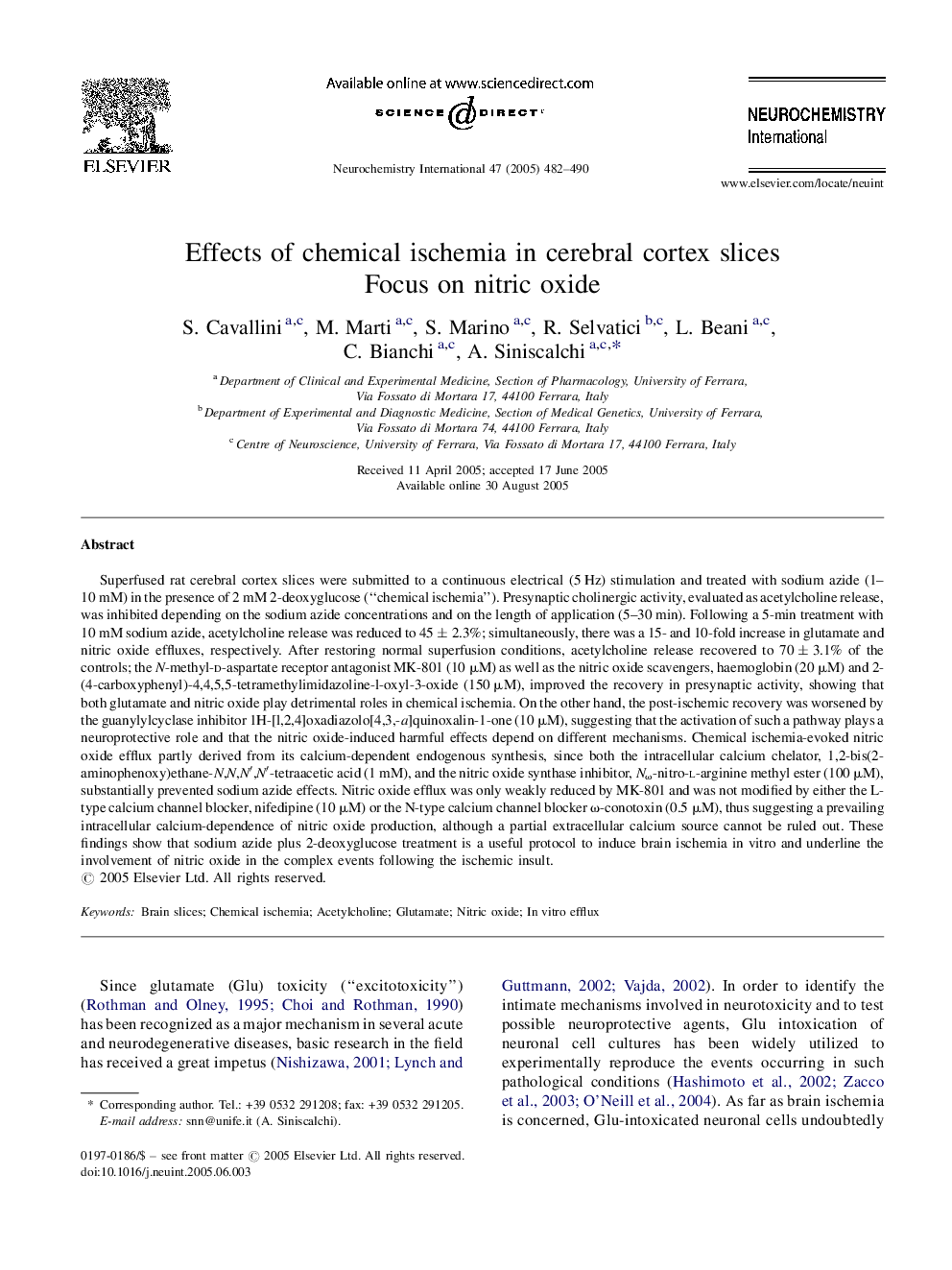| کد مقاله | کد نشریه | سال انتشار | مقاله انگلیسی | نسخه تمام متن |
|---|---|---|---|---|
| 10958450 | 1100070 | 2005 | 9 صفحه PDF | دانلود رایگان |
عنوان انگلیسی مقاله ISI
Effects of chemical ischemia in cerebral cortex slices
دانلود مقاله + سفارش ترجمه
دانلود مقاله ISI انگلیسی
رایگان برای ایرانیان
کلمات کلیدی
موضوعات مرتبط
علوم زیستی و بیوفناوری
بیوشیمی، ژنتیک و زیست شناسی مولکولی
بیولوژی سلول
پیش نمایش صفحه اول مقاله

چکیده انگلیسی
Superfused rat cerebral cortex slices were submitted to a continuous electrical (5 Hz) stimulation and treated with sodium azide (1-10 mM) in the presence of 2 mM 2-deoxyglucose (“chemical ischemia”). Presynaptic cholinergic activity, evaluated as acetylcholine release, was inhibited depending on the sodium azide concentrations and on the length of application (5-30 min). Following a 5-min treatment with 10 mM sodium azide, acetylcholine release was reduced to 45 ± 2.3%; simultaneously, there was a 15- and 10-fold increase in glutamate and nitric oxide effluxes, respectively. After restoring normal superfusion conditions, acetylcholine release recovered to 70 ± 3.1% of the controls; the N-methyl-d-aspartate receptor antagonist MK-801 (10 μM) as well as the nitric oxide scavengers, haemoglobin (20 μM) and 2-(4-carboxyphenyl)-4,4,5,5-tetramethylimidazoline-l-oxyl-3-oxide (150 μM), improved the recovery in presynaptic activity, showing that both glutamate and nitric oxide play detrimental roles in chemical ischemia. On the other hand, the post-ischemic recovery was worsened by the guanylylcyclase inhibitor 1H-[l,2,4]oxadiazolo[4,3,-a]quinoxalin-1-one (10 μM), suggesting that the activation of such a pathway plays a neuroprotective role and that the nitric oxide-induced harmful effects depend on different mechanisms. Chemical ischemia-evoked nitric oxide efflux partly derived from its calcium-dependent endogenous synthesis, since both the intracellular calcium chelator, 1,2-bis(2-aminophenoxy)ethane-N,N,Nâ²,Nâ²-tetraacetic acid (1 mM), and the nitric oxide synthase inhibitor, NÏ-nitro-l-arginine methyl ester (100 μM), substantially prevented sodium azide effects. Nitric oxide efflux was only weakly reduced by MK-801 and was not modified by either the L-type calcium channel blocker, nifedipine (10 μM) or the N-type calcium channel blocker Ï-conotoxin (0.5 μM), thus suggesting a prevailing intracellular calcium-dependence of nitric oxide production, although a partial extracellular calcium source cannot be ruled out. These findings show that sodium azide plus 2-deoxyglucose treatment is a useful protocol to induce brain ischemia in vitro and underline the involvement of nitric oxide in the complex events following the ischemic insult.
ناشر
Database: Elsevier - ScienceDirect (ساینس دایرکت)
Journal: Neurochemistry International - Volume 47, Issue 7, December 2005, Pages 482-490
Journal: Neurochemistry International - Volume 47, Issue 7, December 2005, Pages 482-490
نویسندگان
S. Cavallini, M. Marti, S. Marino, R. Selvatici, L. Beani, C. Bianchi, A. Siniscalchi,